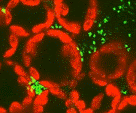Plant Pathology, Department of

Department of Plant Pathology: Faculty Publications
ORCID IDs
Document Type
Article
Date of this Version
10-2007
Citation
Stenger, D. C., Young, B. A., Qu, F., Morris, T. J., and French, R. 2007. Wheat streak mosaic virus lacking helper component-proteinase is competent to produce disease synergism in double infections with Maize chlorotic mottle virus. Phytopathology 97:1213-1221.
Abstract
The tritimovirus Wheat streak mosaic virus (WSMV) and the machlomovirus Maize chlorotic mottle virus (MCMV) each cause systemic chlorosis in infected maize plants. Infection of maize with both viruses produces corn lethal necrosis disease (CLND). Here, we report that complete deletion of the WSMV helper component-proteinase (HC-Pro) coding region had no effect on induction of CLND symptoms following coinoculation of maize with WSMV and MCMV. We further demonstrated that elevation of virus titers in double infections, relative to single infections, also was independent of WSMV HC-Pro. Thus, unlike potyvirus HC-Pro, WSMV HC-Pro was dispensable for disease synergism. Because disease synergism involving potyviruses requires HC-Promediated suppression of posttranscriptional gene silencing (PTGS), we hypothesized that WSMV HC-Pro may not be a suppressor of PTGS. Indeed, WSMV HC-Pro did not suppress PTGS of a green fluorescent protein (GFP) transgene in an Agrobacterium-mediated coinfiltration assay in which potyvirus HC-Pro acted as a strong suppressor. Furthermore, coinfiltration with potyvirus HC-Pro, but not WSMV HC-Pro, resulted in elevated levels of the GFP target mRNA under conditions which trigger PTGS. Collectively, these results revealed significant differences in HC-Pro function among divergent genera of the family Potyviridae and suggest that the tritimovirus WSMV utilizes a gene other than HC-Pro to suppress PTGS and mediate synergistic interactions with unrelated viruses.


Comments
U. S. government work.